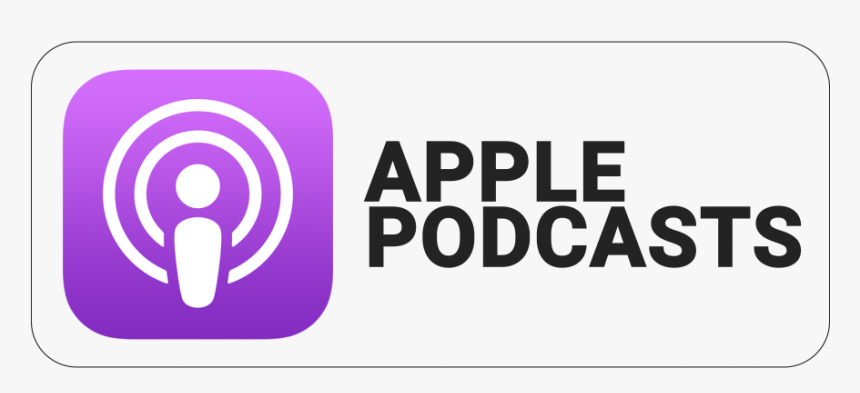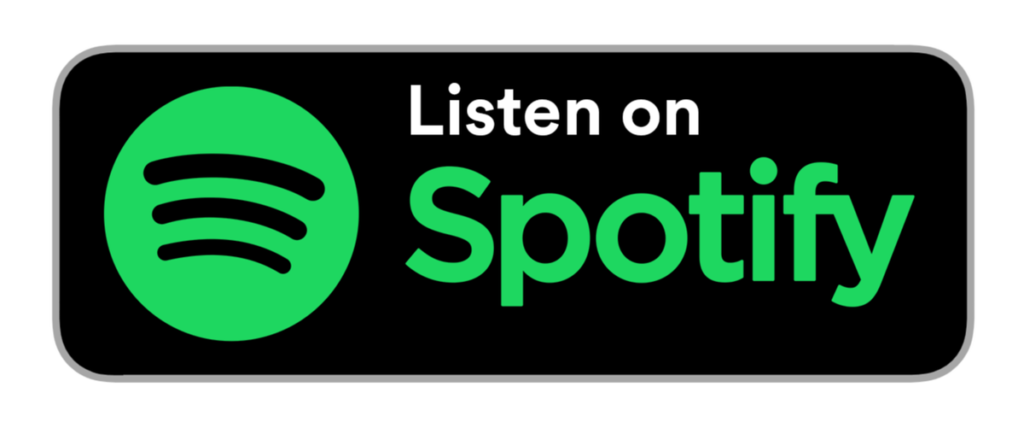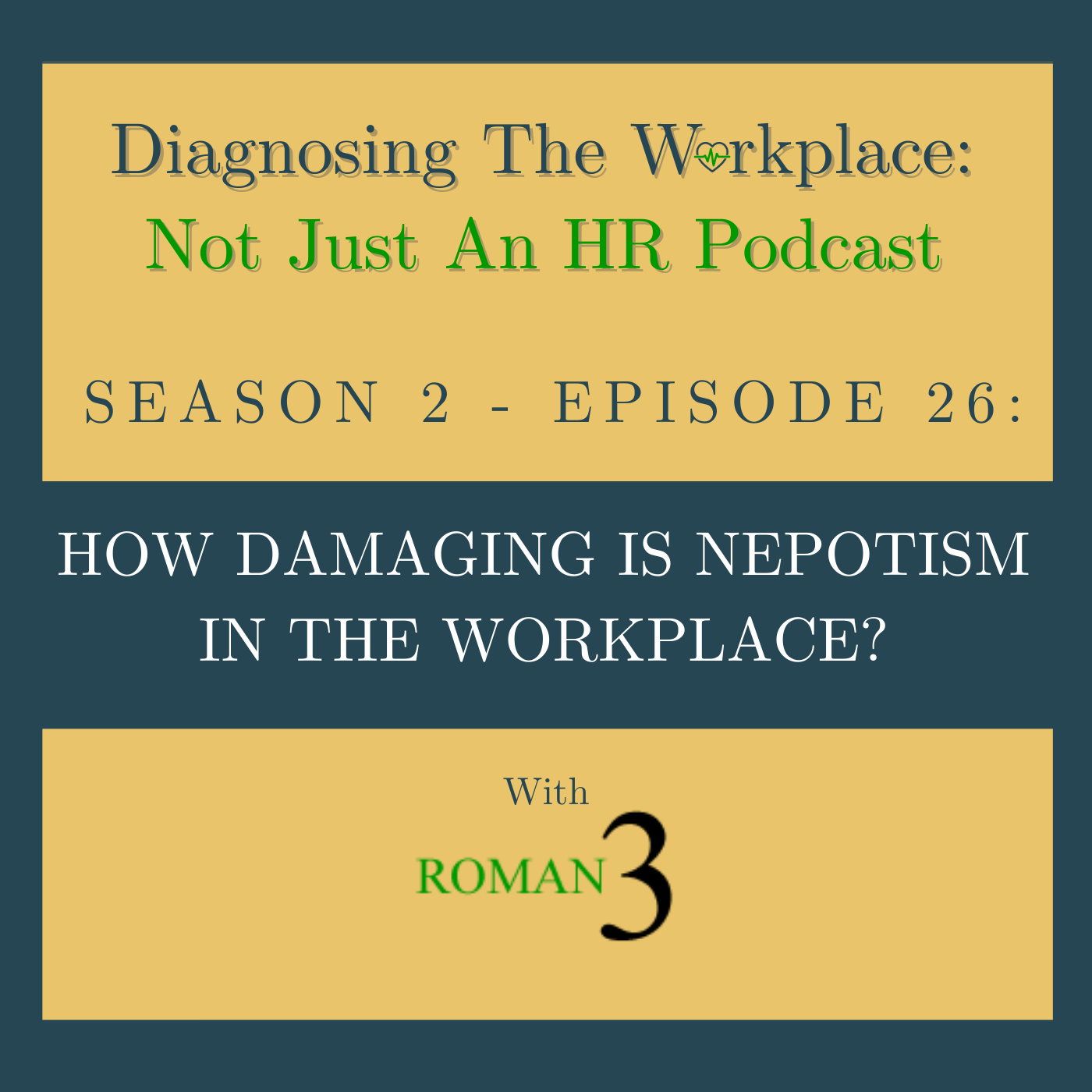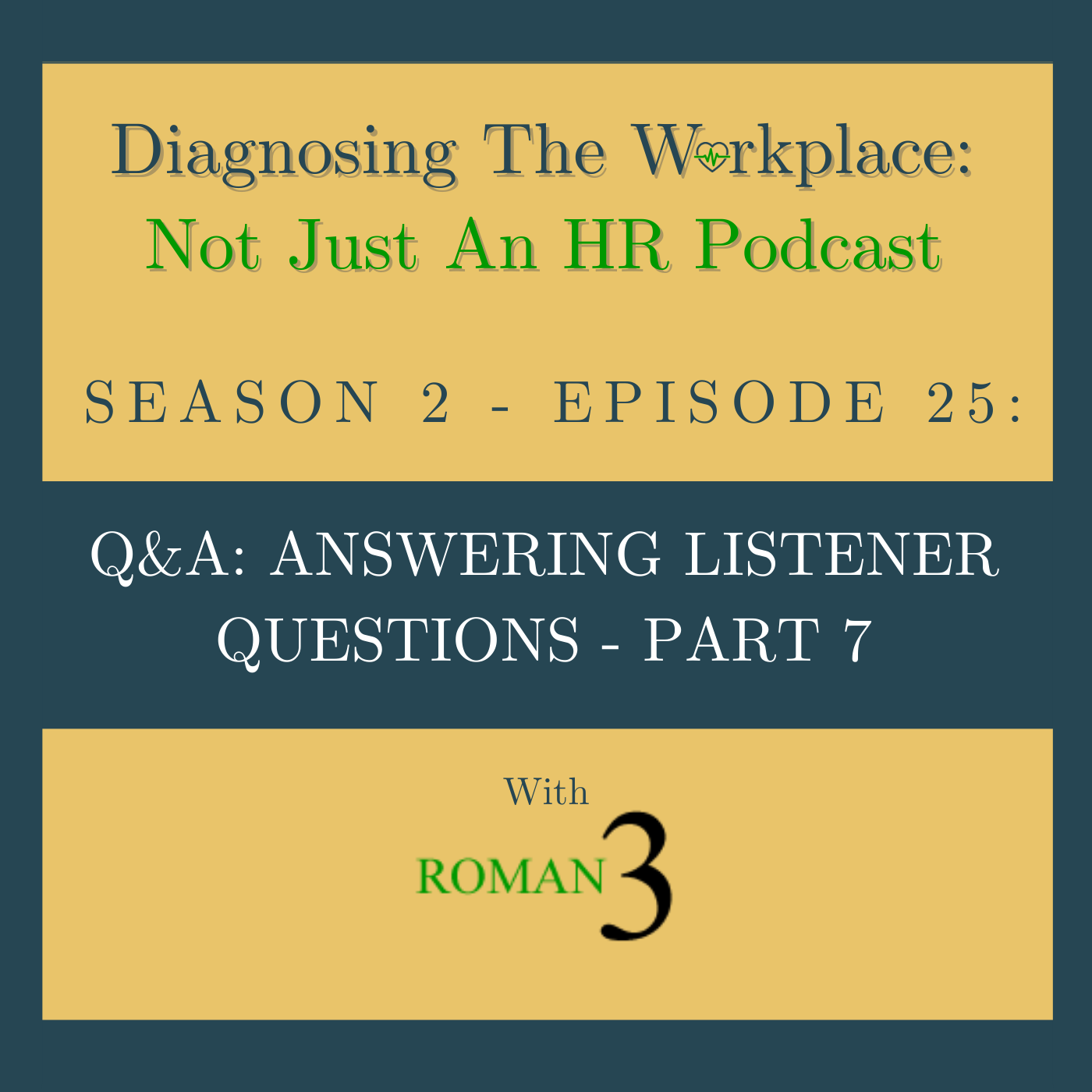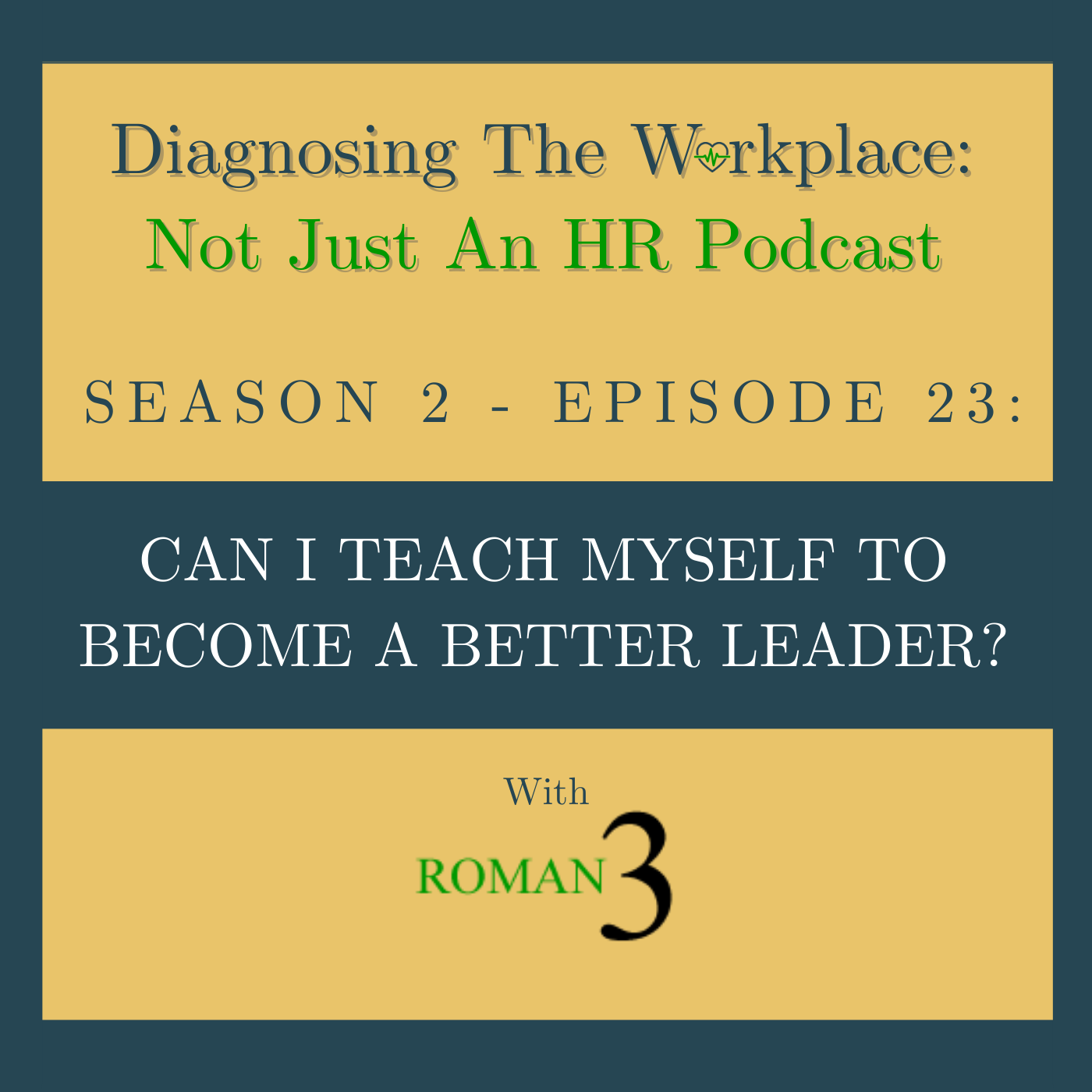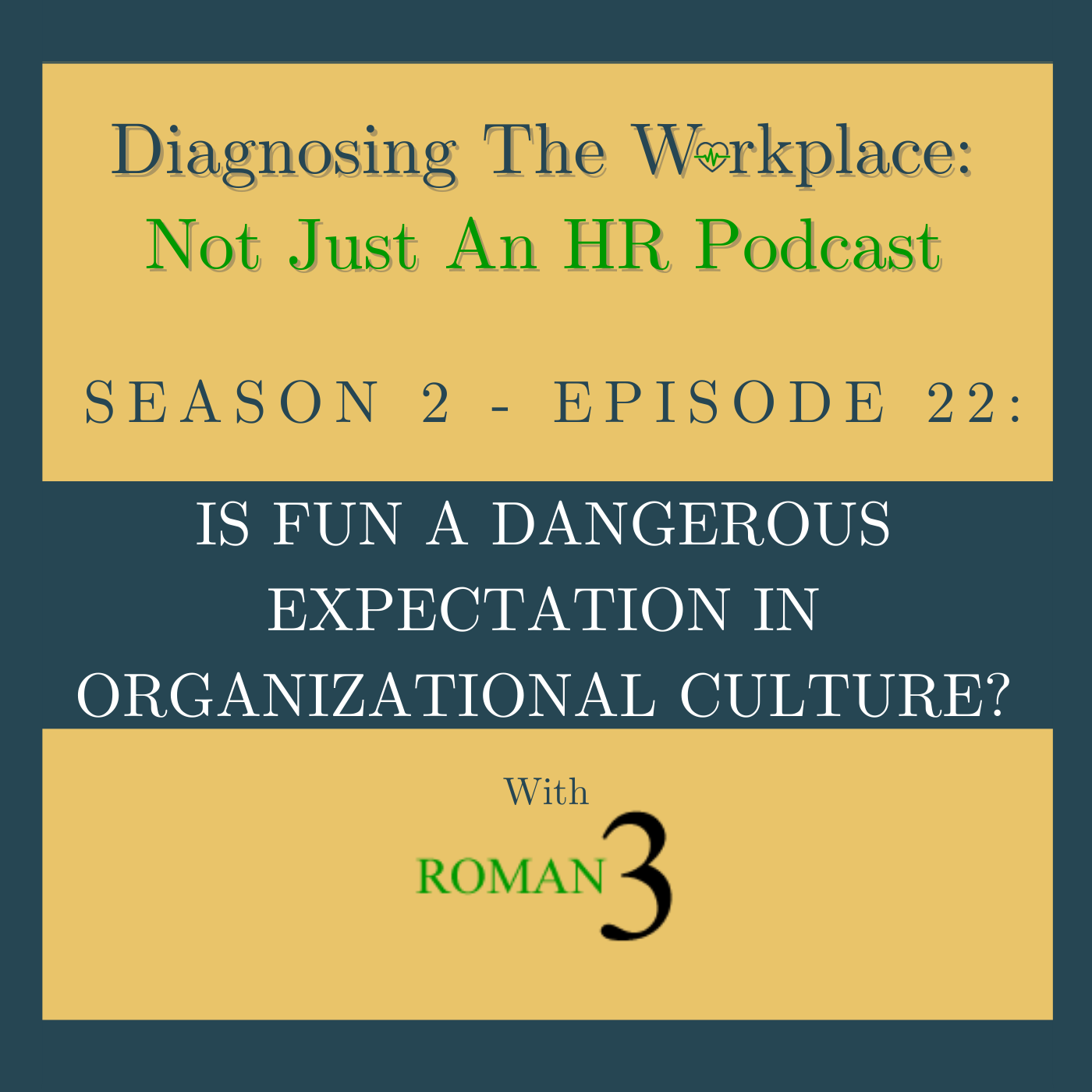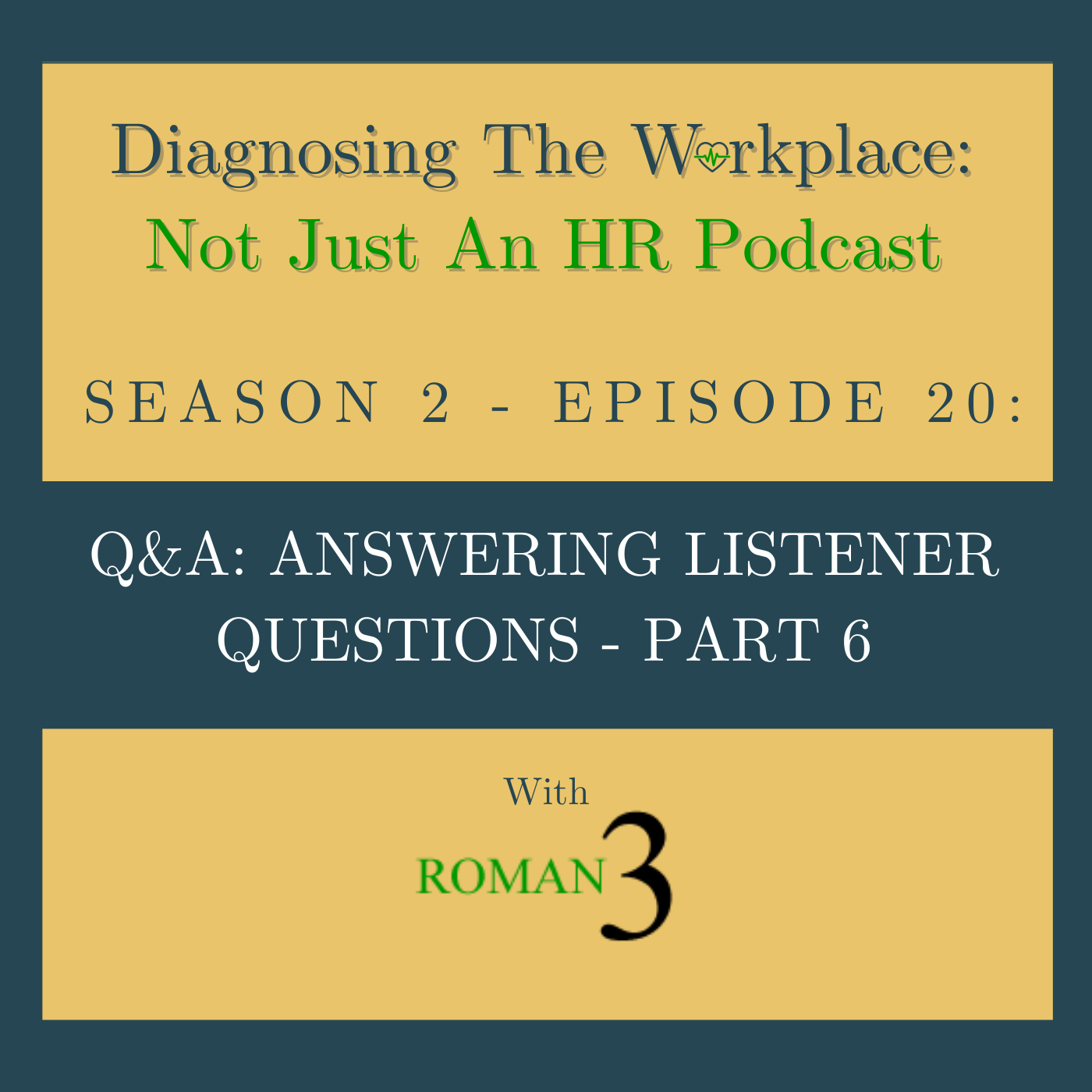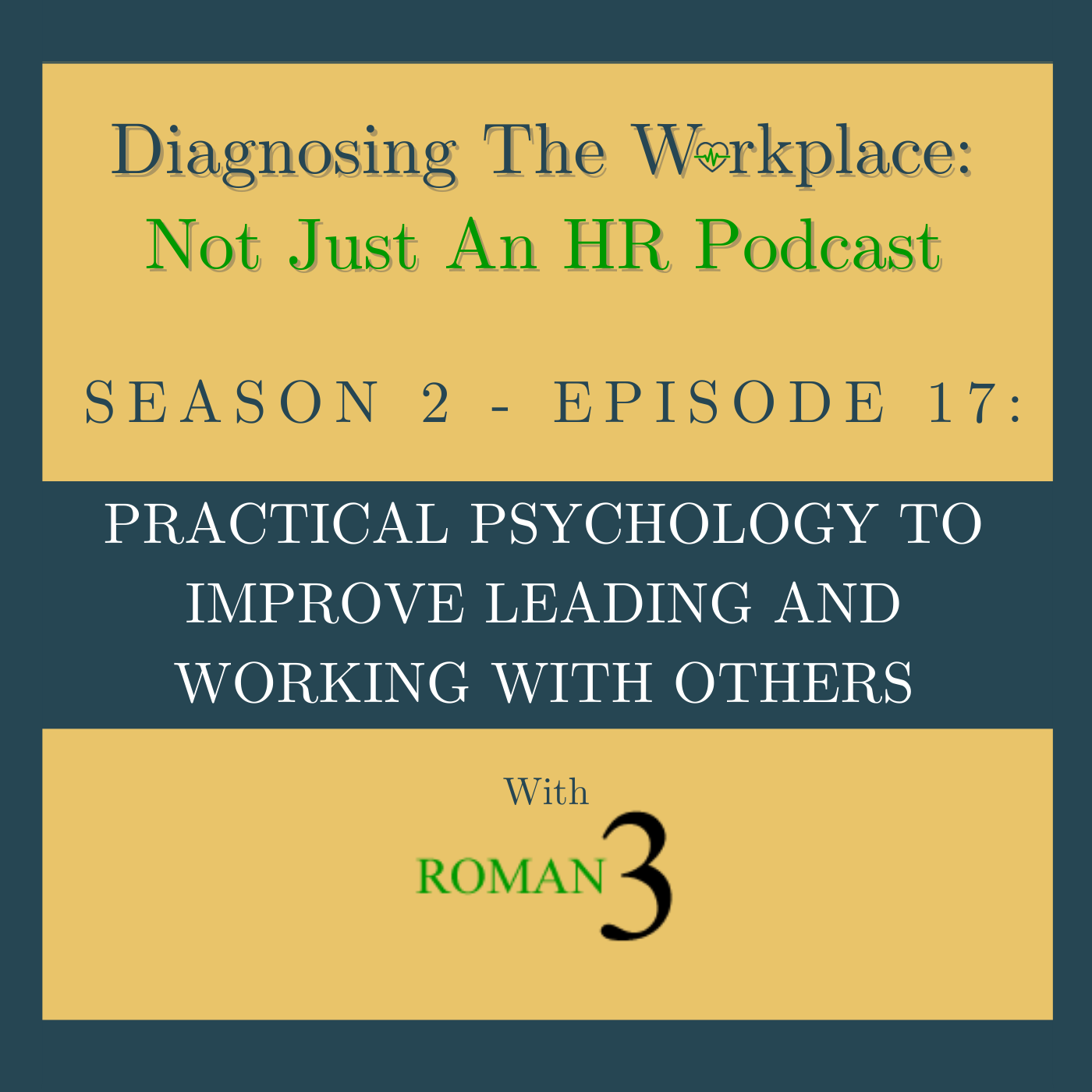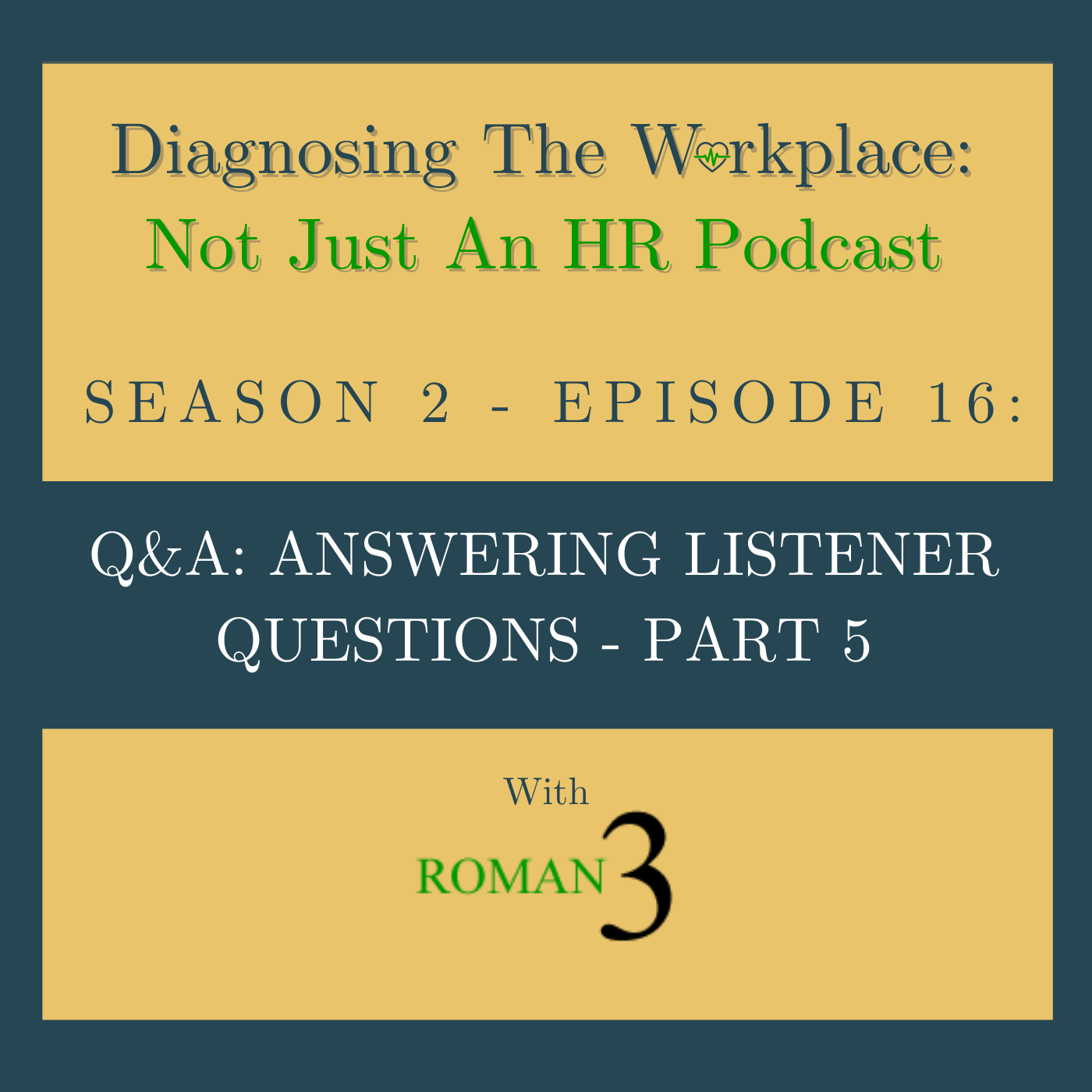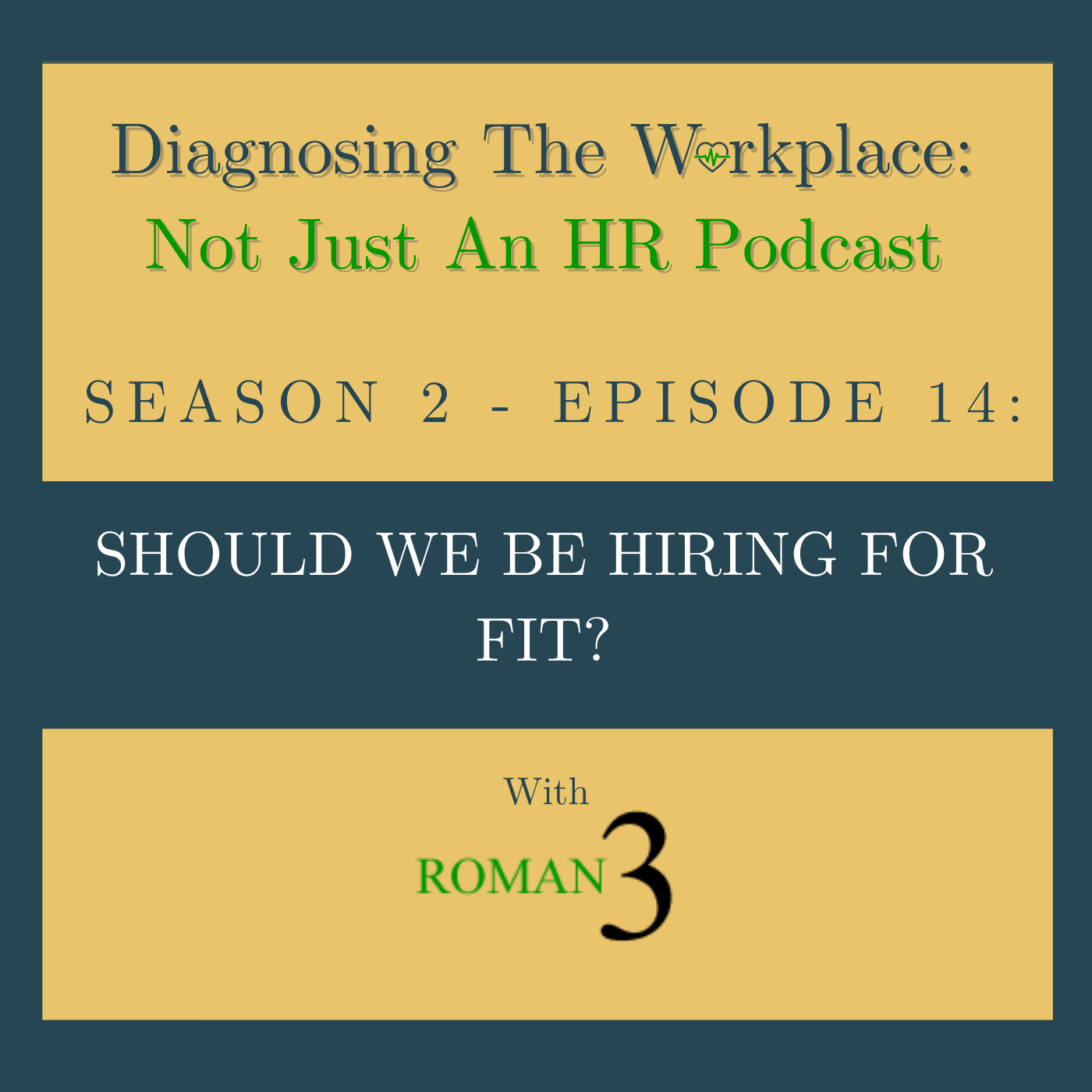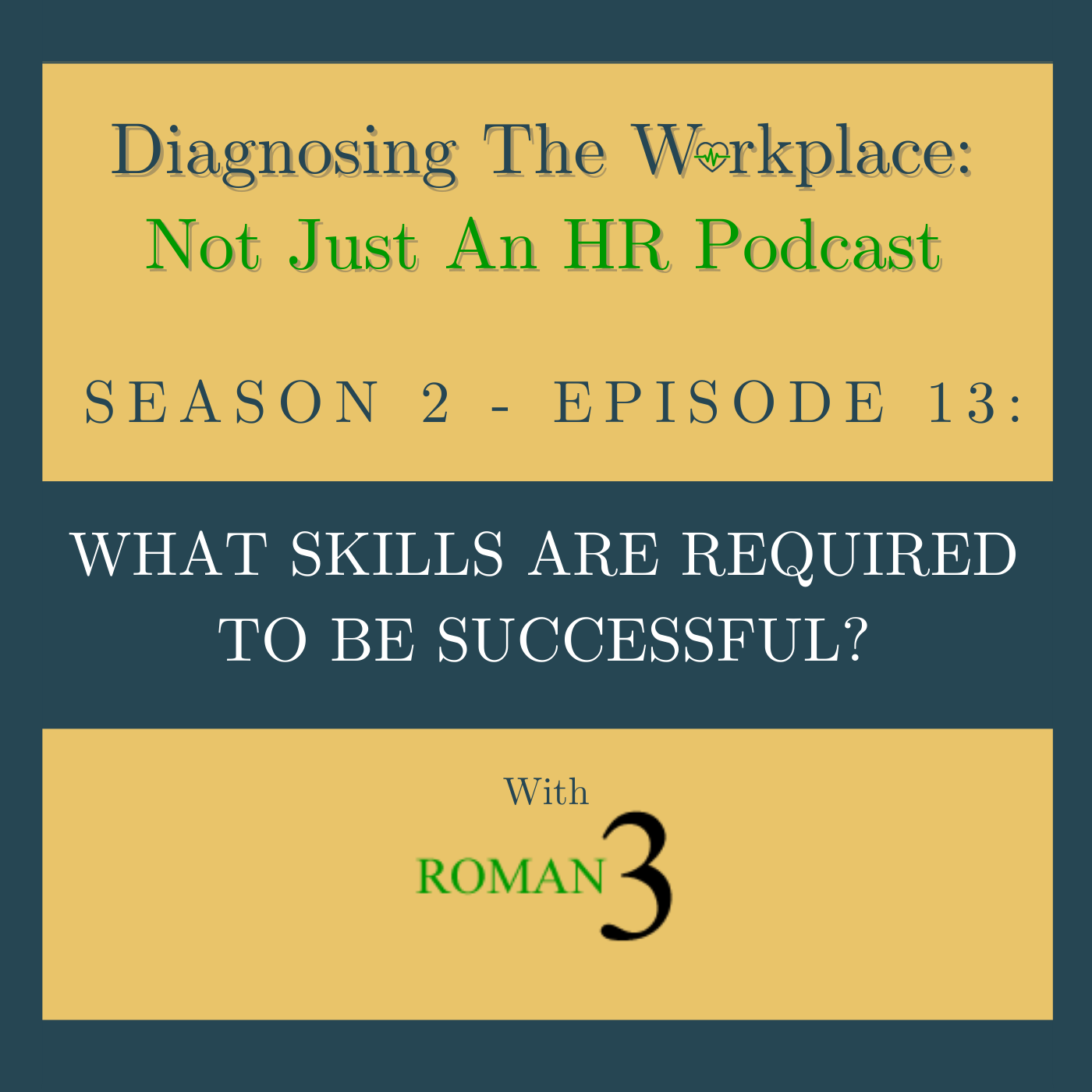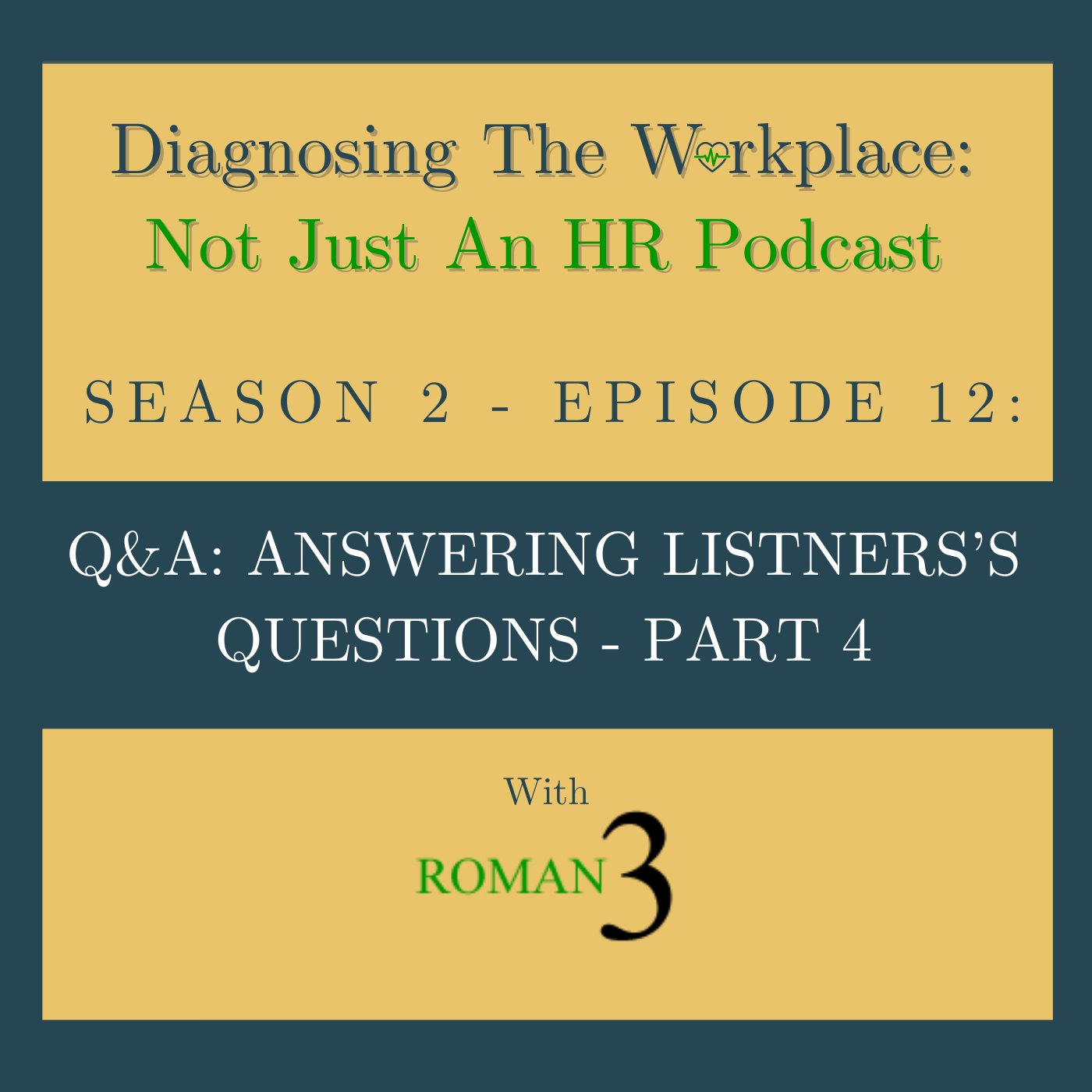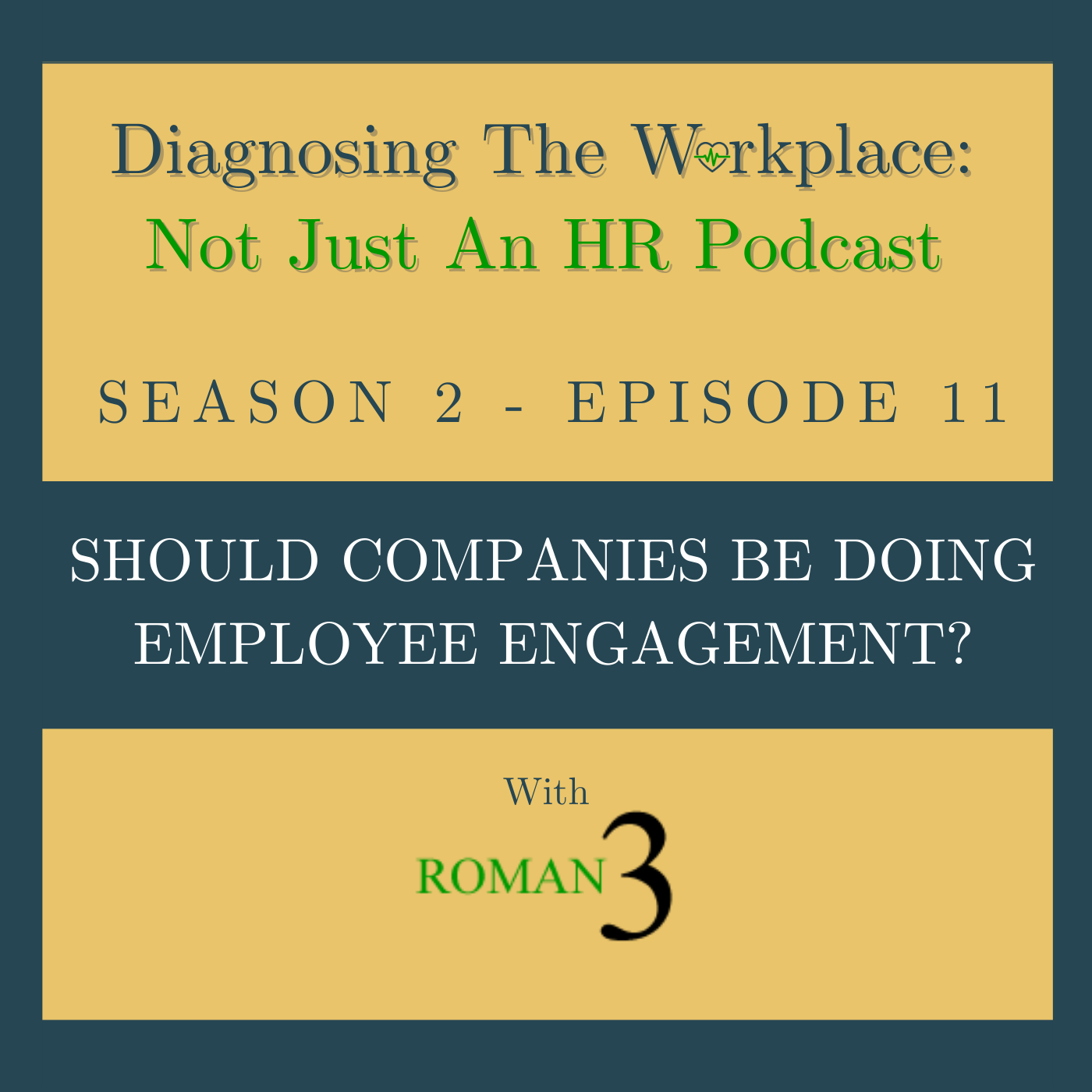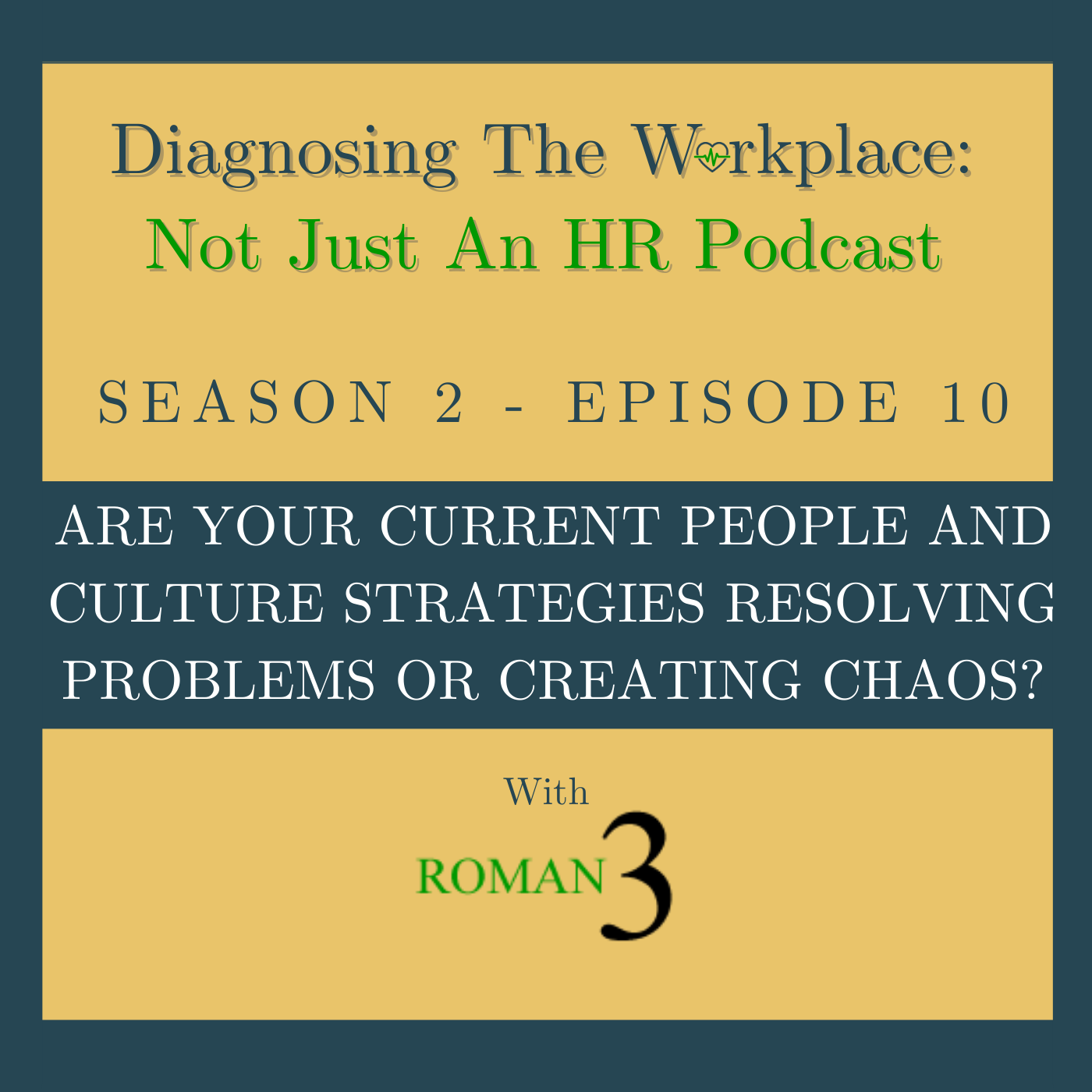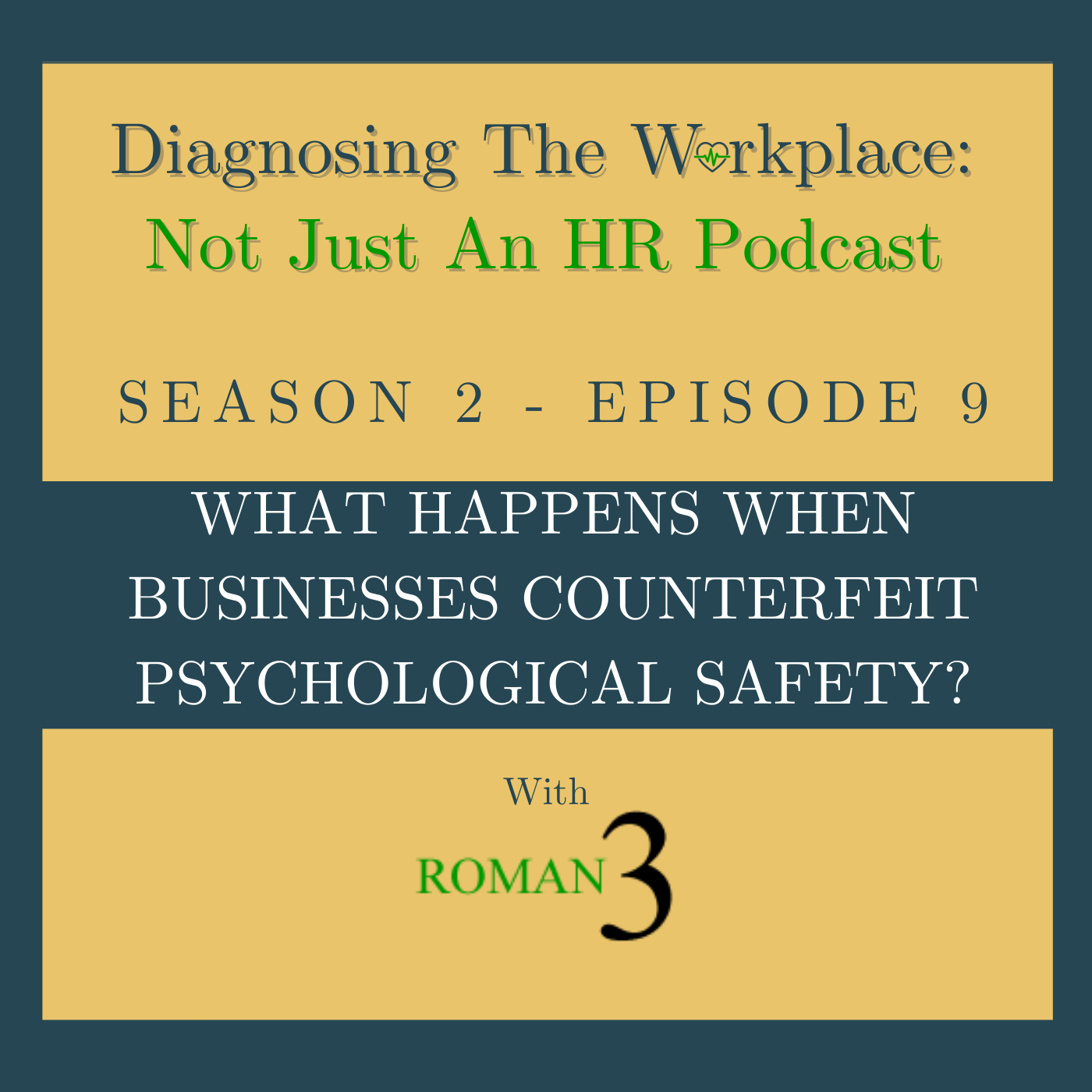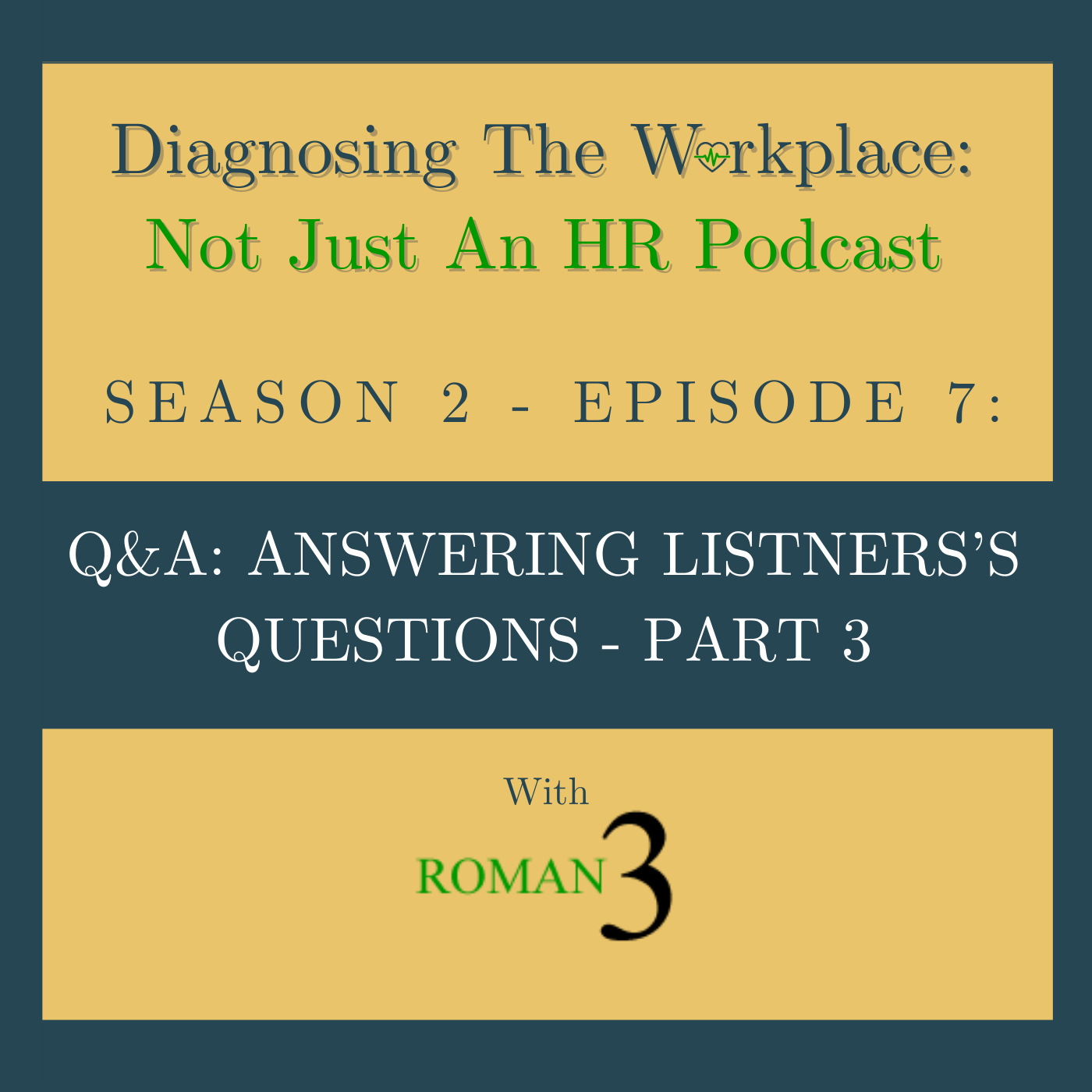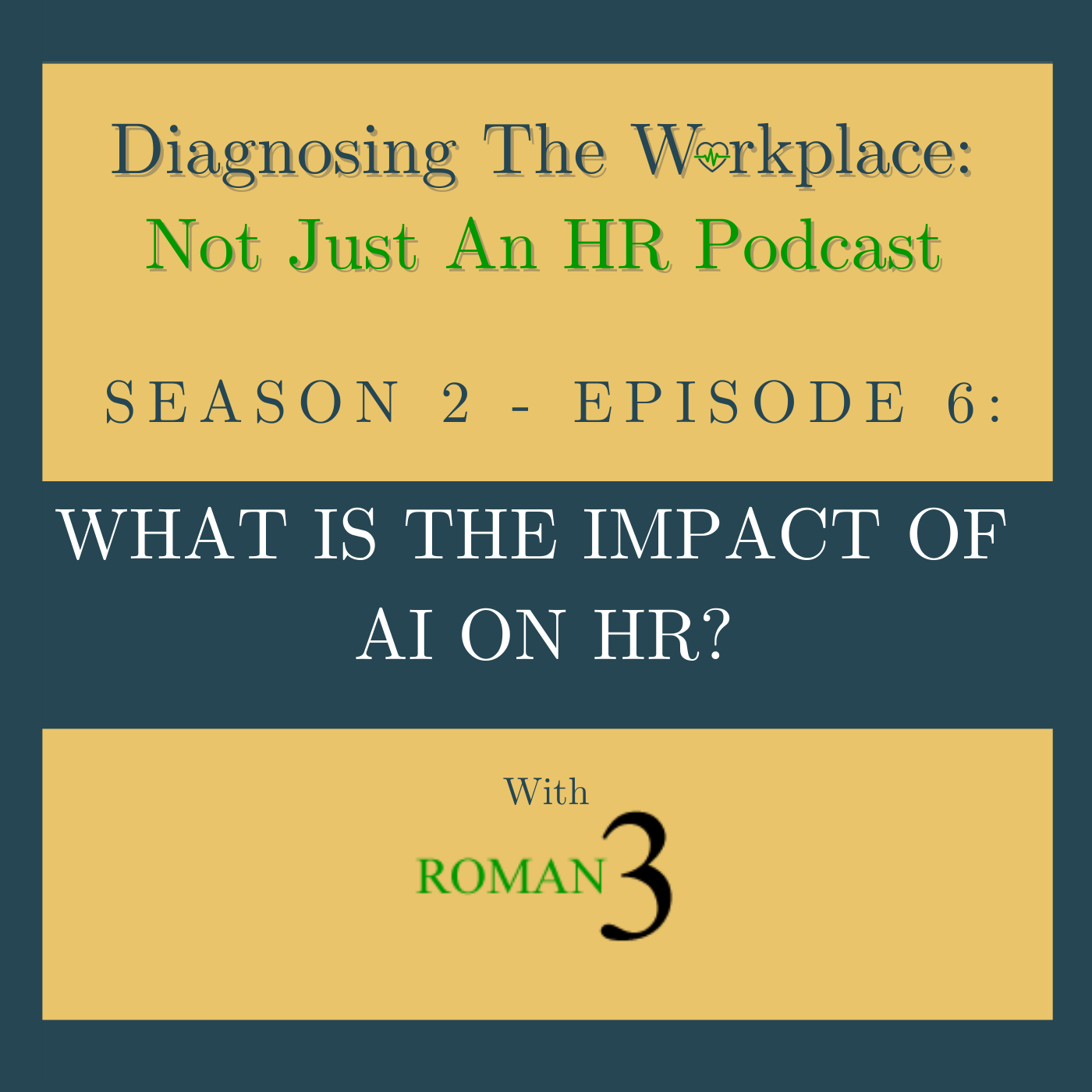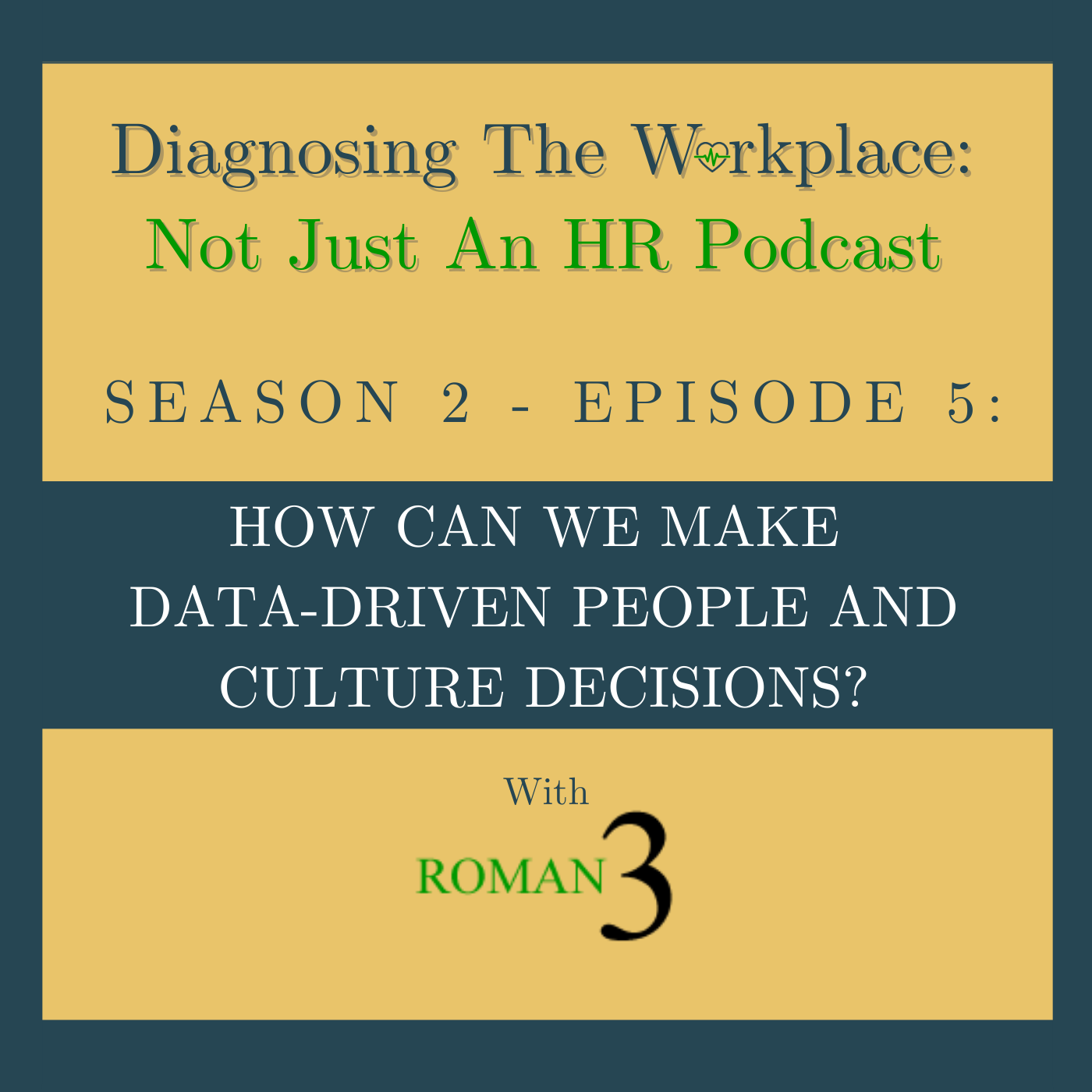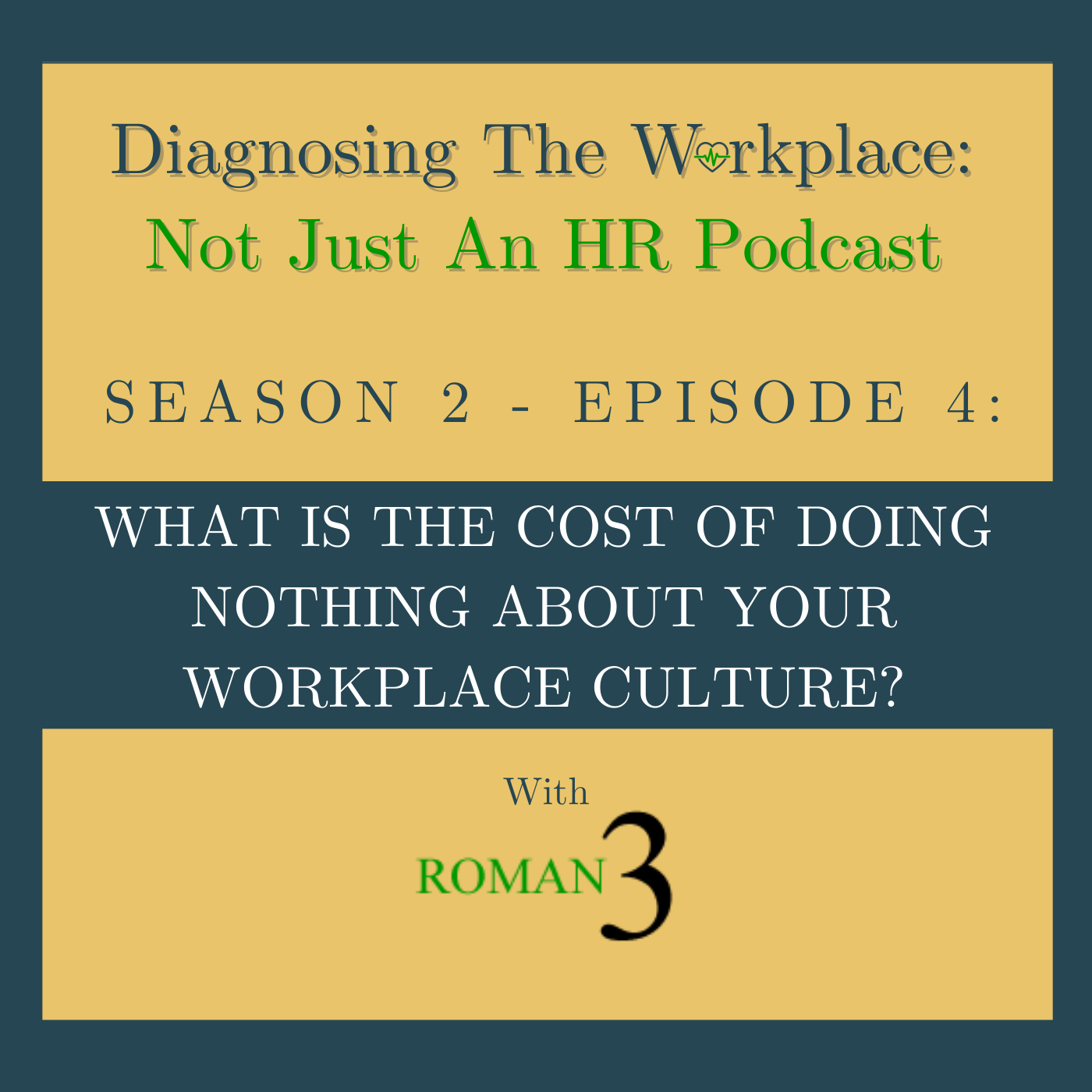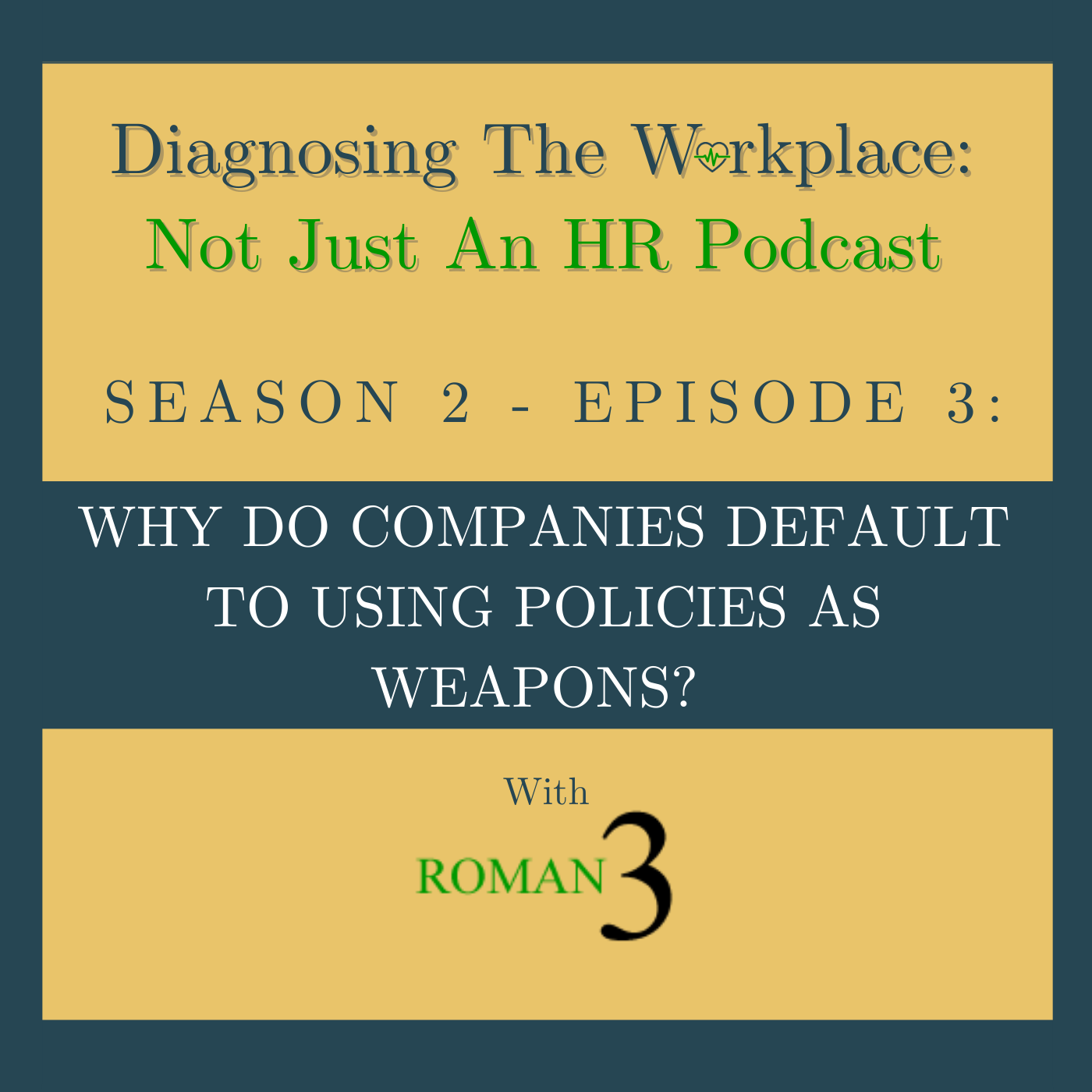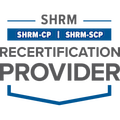- +1 902 932 7300
- Academy@roman3.ca
- Mon - Fri: 9:00am - 9:00pm
- 11 Opportunity Lane, Coldbrook Nova Scotia, Canada B4R 0A5
In this episode, we examine nepotism (the act of granting an advantage, privilege, or position to relatives or friends in an occupation or field) in the workplace. The reality of dealing with hiring family is something many businesses do not handle as well as they should.
Our prescription for this episode: transparency is key. The intent that you have for hiring relatives is something you need to look long and hard at. Also, if there are grumblings and protests about nepotism in your workplace, that may actually be more about how present Job Dissatisfaction is, rather than about nepotism itself.
In this episode, we explore 3 questions from listeners and conversations with clients:
1. What is the difference between Orientation, Onboarding, and Upskilling?
2. How can we address labor gaps due to retirement?
3. How can we Generate Buy-in for anything new?
Our prescription for this episode: have a more strategic approach to how you implement your staffing initiatives. Whether you are training employees, addressing talent shortages, or managing change; take a step back and look at the assumptions you make be making. Can you have a more tactical approach?
In this episode, we examine workforce planning, specifically for small and medium businesses. This is something all businesses know is very important, but few address it with the right approach.
Our prescription for this episode: consider three approaches when looking to build a workforce plan; a Strength-Based Strategy, Temporary Talent, and Succession Planning. These are three practical approaches that should give you more options when looking at your long-term growth.
In this episode, we examine what it takes to become a better leader and the realities of teaching yourself the needed skills and capabilities with books, webinars, and other self-study materials.
Our prescription for this episode: understand that the journey from information to knowledge to wisdom is possible alone, but only in rare situations is it practical. Leadership development is best not tackled alone.
In this episode, we examine the use and misuse of “Fun” in company values, recruitment, and workplace culture.
Our prescription for this episode: take the time to understand the complexity of the actions and initiatives you take when building your employee experience and employer brand. Otherwise, you can end up creating chaos solutions that will have negative and unexpected consequences.
In this episode, we examine what we call “The Technical Founder Paradox”, which we define as: When the skills, abilities, and mindset of the founders, which were crucial to starting and growing the business, are what stand in the way of the business’ sustainability and scalability.
Our prescription for this episode: let’s start looking at the skills we need for growth, whether they are skills we need to develop, hire for, or put in place so we can step back to focus on what we are good at.
In this episode, we explore 3 questions that came up in a recent Employee Retention event:
1. Are organizations underutilizing how they build and use policies?
2. How long do cultural transformations usually take?
3. Are there industry or generational differences in the value of job security?
Our prescription for this episode: develop a broader understanding of these three topics. Policy manuals/handbooks, workplace culture transformations, and job security are things we may not have been seeing with the weight and clarity we needed to get the most out of them.
In this episode, we examine the 4 industry trends that negatively impact the workforce and organizational efficiency. These trends are not necessarily new, but their prevalence is creating greater disruption to organizational success in today’s business climate.
The 4 trends are:
- Primarily family-run businesses not evolving with current business norms.
- Are our human service sectors humane to work in?
- Mergers & Acquisition (M&A) growth strategies often undervalue cultural mergers
- Leaders who are experts in tasks and products, not people management
Our prescription for this episode: take a hard look at the norms in your workplace. Are any (or all) of these trends present where you work? Would some of our recommendations address the root cause of many of your organizational challenges?
In this episode, we examine the 4 Faces of HR. These are defined by the company’s leadership’s expectations and priorities placed on HR professionals. What to the initials of “H” and “R” reflect in how people and culture are managed in your organization?
Does HR stand for…
- Holding Red-tape (primarily a compliance and administration generalist focus)
- Highly Reactive (primarily a talent acquisition focus and “putting our fires” focus)
- Hovering & Restricting (primarily a reporting, discipline, and enforcement focus)
- Humans Required (primarily a human capital, employees as assets focus)
Our prescription for this episode: understand that a human capital strategy is going to be the key to your scalability. If you are not scaling your internal growth in tandem with your external growth you are barreling toward costly and extensive problems.
In this episode, we examine 3 psychological principles that can hopefully provide folks with a lens to allow for a better understanding of those we work with.
In this conversation, we explore:
- Affect Intensity
- Belief Perseverance (combined with the Backfire Effect)
- Self Sabotage
Our prescription for this episode: many interpersonal and professional conflicts arise from a lack of understanding of where a lot of our differences come from. If we take the time to consider the “why” behind people’s behavior, we can bring more patience, grace, and solutions to the troubles of our workplaces.
In this episode, we explore 3 questions posed to us by our listeners:
1. Why do many recognition programs fall short?
2. Why do many teams give up on people and culture initiatives?
3. How can a new manager improve things when they do not have the authority to change them?
Our prescription for this episode: understand the complexity of efforts, changes, and programs you want to implement. Anything involving people is naturally complex, so “off the shelf” solutions never work every time, in every situation, for everybody.
If you would like to learn more about the 7 Methods of Recognition, check out our on-demand course: https://academy.roman3.ca/product/sevenfold-recognition-lifting-workplace-morale/
In this episode, we examine what it takes to infuse innovation into your workplace culture, and what are the big warning signs of complacency that will hold back innovation.
Our prescription for this episode: understand the Warning Signs of a Climate of Complanency (CoC), and look to start including the Indicators of Innovation (IoI) if you want to make innovation sustainable in your organization.
Warning Signs of a Climate of Complacency (CoC)
| Comfortable and Traditional methods
| Rigid Thinking
| Finding the No
| Unconfident and Low-profile Leadership
| Indicators of Innovation (IoI)
| Make Failing Part of the Plan
| Mitigate the Risk
| Unfinished is the New Normal
| Confident Leadership
You can reach out to us to talk more about a Culture of Innovation at info@roman3.ca or through our LinkedIn page at https://www.linkedin.com/company/roman3
In this episode, we examine “fit” and how we may have been misunderstanding the reality of hiring for fit.
Our prescription for this episode: avoid the trap of looking for people who will “fit in” and prioritize finding talent who will add value to your organization and who will “be a good fit”.
You can reach out to us to talk more about fit at info@roman3.ca or through our LinkedIn page at https://www.linkedin.com/company/roman3
The 6 Roles of SPECtrum
o Binders are bridge builders. They have very good interpersonal skills and can work with many different kinds of people.
o A Finder is motivated by the chase and has a knack for turning leads into new triumphs. They excel at focusing on the idea.
o Minders are administrators. They are the backbone of a team and keep everything moving and everyone on task.
o Grinders are creators, they are often behind the scenes workhorses that produce significant quantities of high-quality work.
o Pathfinders are explorers. They look for success and innovation, but they need their crew to be with them along the way.
Spellbinders are influencers. They are very persuasive and good at creating convincing, evidence-based arguments.
In this episode, we examine skills and try to bring a fresh perspective to the separation between “soft” or “essential” skills and “hard” or “technical” skills.
Our prescription for this episode: let’s start looking at skills through the lens of Employability, especially in how we recruit, develop talent, and groom people for leadership
You can reach out to us to talk more about Employability Skills at info@roman3.ca or through our LinkedIn page at https://www.linkedin.com/company/roman3
In this episode, we explore 3 questions posed to us by our listeners:
1. How do we know when something is AI or just marketed as AI?
2. How do you handle a toxic employee?
3. How can I implement wellness accommodations for a team member without burning out everyone else on the team?
Our prescription for this episode: never underestimate the negative impact of job dissatisfaction and poor psychological safety. Toxic employees, employee burnout, and low productivity are natural outcomes of a workplace culture that is riddled with job dissatisfaction.
You can reach out to us with your own questions, at info@roman3.ca or through our LinkedIn page at https://www.linkedin.com/company/roman3
Statistic Referenced:
Housman and Minor (2015). Toxic Workers, Harvard Business School.
In this episode, we examine what it means to “do” employee engagement. Our conversation explores the pitfalls that come from not truly understanding employee engagement and the consequences of doing it wrong.
Our prescription for this episode: understand that employee engagement is an outcome, not an activity. There are very practical and tangible things you can do that will create motivation and enthusiasm in employees, but you need to be strategic in your efforts.
You can reach out to us to talk more about RAMP at info@roman3.ca or through our LinkedIn page at https://www.linkedin.com/company/roman3
In this episode, we examine an all-to-common situation in most workplaces – Chaos Solutions. This is the reality of not fully understanding the complexity of workplace challenges or looking for shortcuts to resolve issues, which ultimately creates more harm than good.
Our prescription for this episode: we need to think critically about the situations we are trying to resolve and ask ourselves the question: “What needs to exist first before this solution will be effective.”
You can reach out to us to talk more about avoiding Chaos Solutions at info@roman3.ca or through our LinkedIn page at https://www.linkedin.com/company/roman3
In this episode, we examine what it looks and feels like when a workplace has counterfeited psychological safety, or to put it another way, has made some of the easy steps to merely create the illusion of psychological safety.
Our prescription for this episode: understand the red flags for counterfeit psychological safety, and take the time to learn, measure, and effectively engrain psychological safety into your workplace is you really want to reap the benefits of it.
You can reach out to us to talk more about psychological safety at info@roman3.ca or through our LinkedIn page at https://www.linkedin.com/company/roman3
In this episode, we examine the important workforce events that happened in 2023, as well as what we should be the fundamental takeaways from this very busy year. We identify 5 main lessons to learn from 2023 that will impact our success in 2024.
Our prescription for this episode: realize that things have permanently changed, and if we want to have success going forward, we need to think differently, revise our priorities, and move beyond the traditional way of doing things.
Past Podcast Episodes Referenced:
The 7X3 Rule:
S2 E15 – Is Job Dissatisfaction Really That Dangerous
The Autonomy Freeway:
S2 E6 – Can we fix talent attraction and burnout with PTO
Fractional HR Supports:
S2 E25 – When Should A Small Business Prioritize HR And Their Workplace Culture
AI in the Workplace
S2 E6 – What Is The Impact Of AI On HR
In this episode, we explore 3 questions posed to us by our listeners:
1. What are the biggest risks facing small businesses around HR compliance?
2. How do you make coaching and team building programs have a lasting effect in a workplace?
3. How do you effectively measure DEI?
Our prescription for this episode: pay attention and look for effective ways to evaluate the work environment that you and your employees work in. A huge risk that every business faces is what we don’t know. Making the need to properly view and measure our workplace an essential part of reducing risk and creating success.
You can reach out to us with your own questions, at info@roman3.ca or through our LinkedIn page at https://www.linkedin.com/company/roman3
Past Episodes Referenced:
Episode 25: When Should A Small Business Prioritize HR And Their Workplace Culture?
Episode 22: What Is Missing From Diversity, Equity, and Inclusion (DEI)?
In this episode, we examine the realities of artificial intelligence (AI) in our workplaces, specifically looking at its impact on Human Resources. We break down AI into practical terms with the intent to make its use and integration into our workplaces more practical and meaningful.
Our prescription for this episode: understand what is and is not AI, as there are a lot of misconceptions out there. Also start thinking of AI as a productivity tool, that is like adding another member to your team.
Statistics referenced:
49% of HR professionals say they leverage seven or more employment systems of record, inclusive of their HRIS, ATS, benefits administration, payroll, and time-tracking systems.
38% of HR professionals whose organizations have more than 1,000 employees report having ten or more employment systems in their tech stack.
The vast majority (84%) of HR executives at the VP level or higher (e.g., Head of HR, CHRO, etc.) believe their teams are using generative AI, yet only 34% of individual contributors report doing so.
– Finch. Early Look: Finch Survey Finds Many Opportunities to Improve the Employment Tech Stack. (2023)
In this episode, we examine the importance of collecting, not just any data, but the right data to inform your People and Culture decisions. We highlight the importance of having targeted diagnostic tools to make smart business decisions that will improve organizational efficiency.
Our prescription for this episode: think beyond surveys when collecting data. Many rich sources of data can come from tasks, assets, and efforts you likely already have.
If you would like to learn more about People and Culture diagnostic tools, and/or our OCEAN suite of tools, let us know at info@roman3.ca or check out operations.roman3.ca/for-organizations.
In this episode, we examine the hidden costs that come with typical workplace culture challenges. We call these additional expenses and productivity wastes Labour Value Loss, and they eat away at profits and potential in almost every business.
Our prescription for this episode: understand that doing nothing about these everyday challenges comes at a steep cost, whether you are aware of the problems or not.
Statistics referenced:
On average, companies are running at 33% efficiency.
– Gallup. Treat Your People Like Assets, Not Expenses — Invest in Them (2019)
The result of 22 case studies show a typical cost of turnover of 20% of salary.
– Center for American Progress. There Are Significant Business Costs to Replacing Employees Report (2012)
The cost of burnout-related absences and lost productivity can be close to 25% of an employee’s annual salary.
– Morneau Shepell. Morneau Shepell’s Annual Mental Health Index (2022)
The relationship between Sexual Harassment and reduced productivity has been directly established. A person experiencing Sexual Harassment losses productivity equivalent to 45% of their annual salary.
– Willness, Steel & Lee. A Meta-Analysis Of The Antecedents And Consequences Of Workplace Sexual Harassment. University of Calgary. (2007)
An uncivil workplace (where microaggressions and rude/passive aggressive behavior are common) can reduce employee performance to a cost of $14,000 annually, or about 26% of the average annual salary.
– Pearson, C., & Porath, C. The Cost of Bad Behavior: How Incivility Is Damaging Your Business and What to Do About It (2009)
Research by Grammarly and The Harris Poll found poor workplace communication is a pervasive problem burdening businesses and employees alike costing businesses approximately $12,506 per employee every year or 21% of that average employee’s annual salary.
– Grammarly and The Harris Poll. State of Business Communication report (2023)
The need for additional wages to make up for a poor reputation as a bad employer, businesses need to spend about $4,723, or at least 10% more, per hire to convince a candidate to take a job at such a company.
– Harvard Business Review, A Bad Reputation Costs a Company at Least 10% More Per Hire (2016)
In this episode, we examine the all-to-common reality of organizations and managers using rules, standards, and policies as weapons to control, retaliate, and oppress employees.
Our prescription for this episode: understand where this common practice of using policies as weapons comes from, and realize that there are more effective ways to create rules and policies that will yield far better results and employee performance.
Email us with your stories of the Policies as Weapons at info@roman3.ca.
Quick Correction: The Three Fragile Grips are The Harsh Grip, The Weak Grip, and The Stable Grip (Not the Supportive Grip)
Statistics referenced:
59% of managers report having no training at all.
– West Monroe. Companies are Overlooking a Primary Area for Growth and Efficiency: Their Managers (2018)
A manager or supervisor directly influences a shocking 70% of an employee’s motivation and engagement.
– Gallup. The Gallup Business Journal (2015)
In this episode, we examine the difficult reality of managing a workplace full of employees with different political and social views. How can we employees get past their differences and find common ground in the workplace?
Our prescription for this episode: we need to broaden our view of others. People are complex and we need to see past the parts we disagree with and look to find alignment in the harder-to-see, but certainly present, areas that we can agree with.
In this episode, we examine the different aspects of wellness in the workplace and explore the potential challenges and areas of growth that can come with improving employees’ physical, mental, and emotional health.
Our prescription for this episode: understand that wellness strategies cannot be successful in a silo. We need to look at physical, mental, AND emotional health all together. Employee wellness is how you maintain employees in the long term.
Statistics referenced:
Employees take an average of 4 sick days a year, but admit to being unproductive an average of 57.5 days a year.
-GCC Insights. Clocking on and Checking out: Why Your Employees May Not Be Working at Optimal Levels and What You Can Do About It. (2016)
The cost of burnout-related absences and lost productivity can be close to 25% of an employee’s annual salary.
-Morneau Shepell. Annual Mental Health Index. (2022)
For a little more on our ideas and concepts, check out our Knowledge Suite or our YouTube Channel, Solutions Explained by Roman 3.


